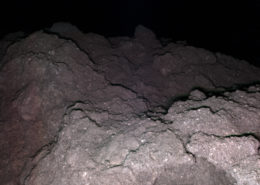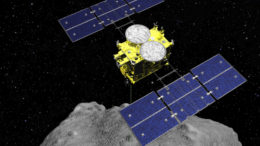Samples from the near-Earth asteroid (162173) Ryugu recently arrived at Earth, ready for laboratory analysis. In the meantime, ground-based measurements of Ryugu’s surface are helping us to complete our picture of this nearby, rocky body.
Observations on Earth and from Earth
In December 2020, the Japanese spacecraft Hayabusa2 completed a daring 6-year mission, successfully landing on near-Earth asteroid Ryugu and returning a sample of this body’s material to Earth. Laboratory analysis of the sample is sure to provide valuable new insight into the structure and composition of the surface of this carbonaceous asteroid. But while we’re waiting for those results, there’s more to be learned from ground-based observations!One way to study the surfaces of nearby objects is by making polarization measurements, which track the orientation of light waves reflected off of an object. In the case of an airless body like Ryugu, the amount of polarization measured from different viewing angles can tell us about the surface texture of the object.
In a new study led by Daisuke Kuroda (Kyoto University, Japan), scientists report the first polarization measurements of Ryugu, captured by four different observatories based in Japan and South Korea.

Phase angle–polarization dependence of near-Earth asteroids and cometary nuclei. The solid red circles represent the polarimetric data for Ryugu, marking the highest polarization measured for such an object thus far. [Kuroda et al. 2021]
Breaking Records
Kuroda and collaborators used data gathered between September and December 2020 to measure the linear polarization of light scattered off of Ryugu as the angle between the Earth, Ryugu, and the Sun changed. The authors’ measurements covered a range of this phase angle spanning 28° to 104°.
The authors find that Ryugu exhibits the highest polarization degree ever measured for an asteroid or comet: as much as 53% of the light from Ryugu was linearly polarized at a phase angle of 100°!
This large degree of polarization is consistent with the asteroid’s low albedo. Why? Light wave orientations are scrambled by repeated reflection and refraction, resulting in lower polarization. For dark objects with poor reflectivity, like Ryugu, the reduced scattering results in higher polarization.
A Grainy Surface

Color photo of the surface of Ryugu, taken by the MASCOT lander deployed by Hayabusa2. [MASCOT/DLR/JAXA]
When we complete the analysis of the actual surface material returned from Ryugu by Hayabusa2, those results will provide valuable context for the polarimetric observations presented here — and vice versa! The combination of these data will help us to learn more from future observations of our near-Earth rocky neighbors.
Citation
“Implications of High Polarization Degree for the Surface State of Ryugu,” Daisuke Kuroda et al 2021 ApJL 911 L24. doi:10.3847/2041-8213/abee25



1 Comment
Pingback: Allgemeines Live-Blog ab dem 29. April | Skyweek Zwei Punkt Null